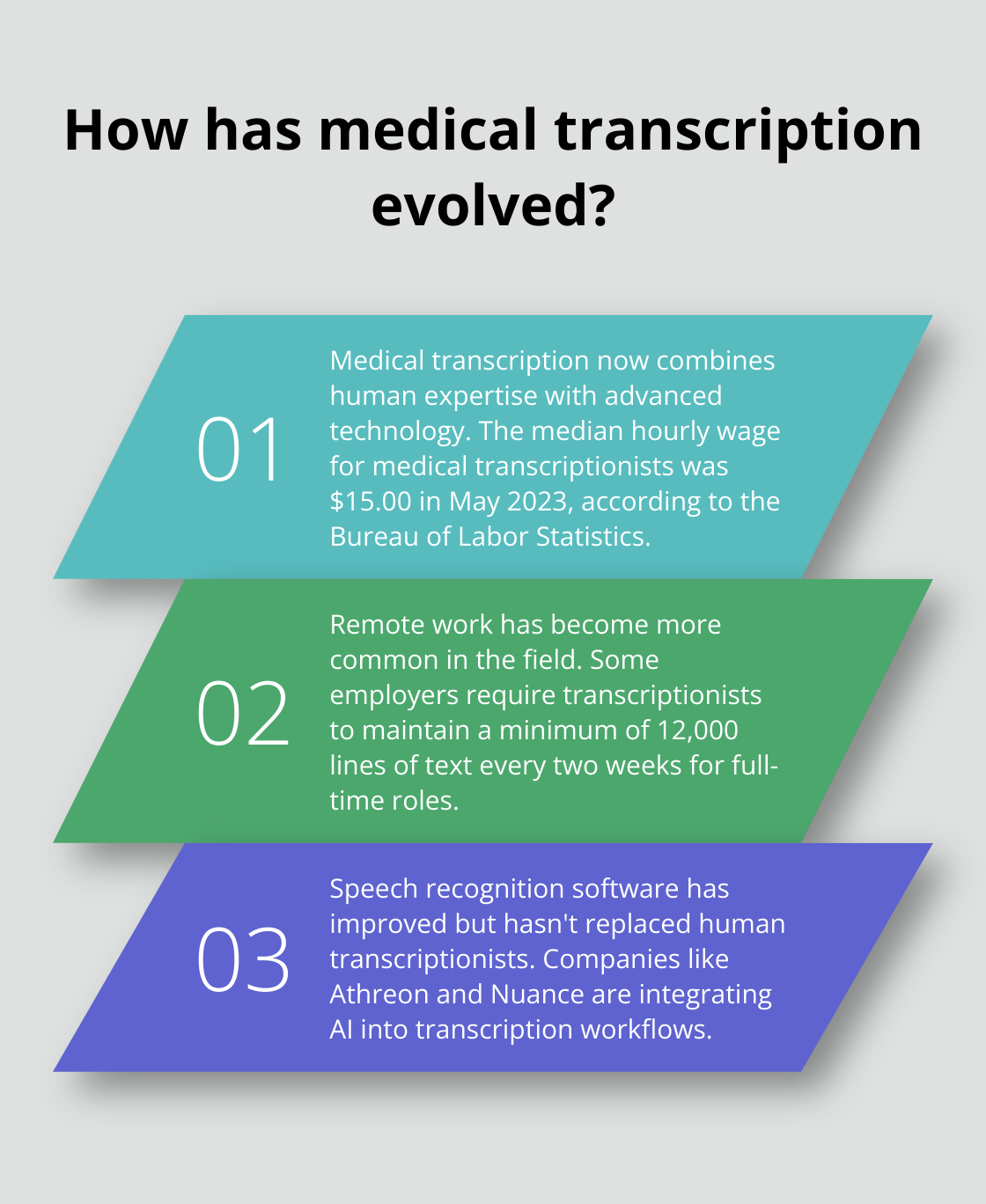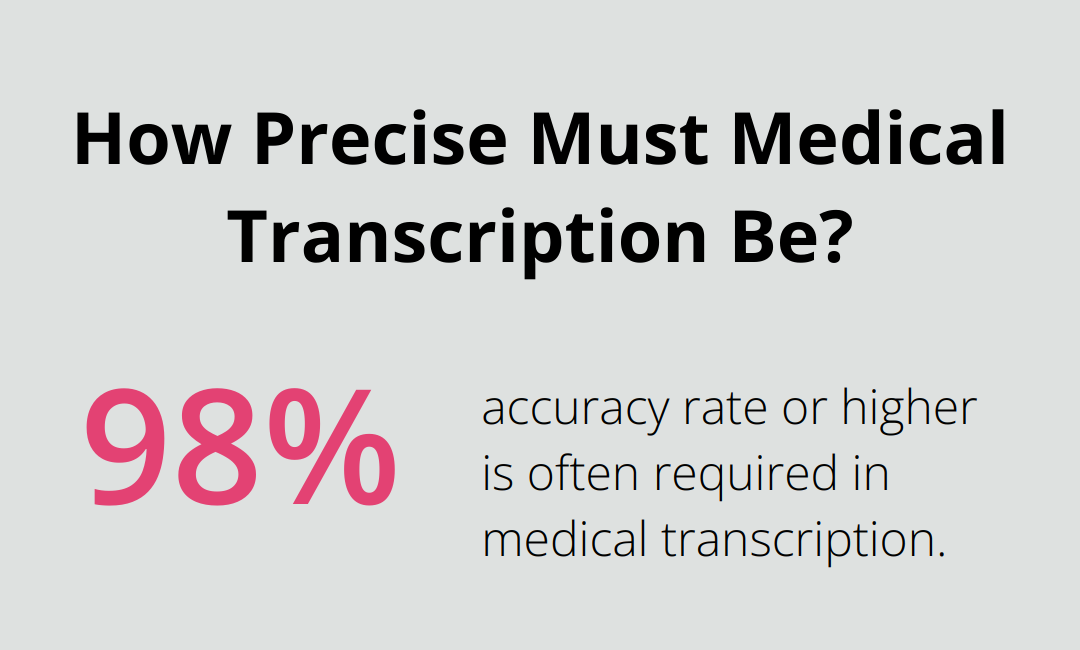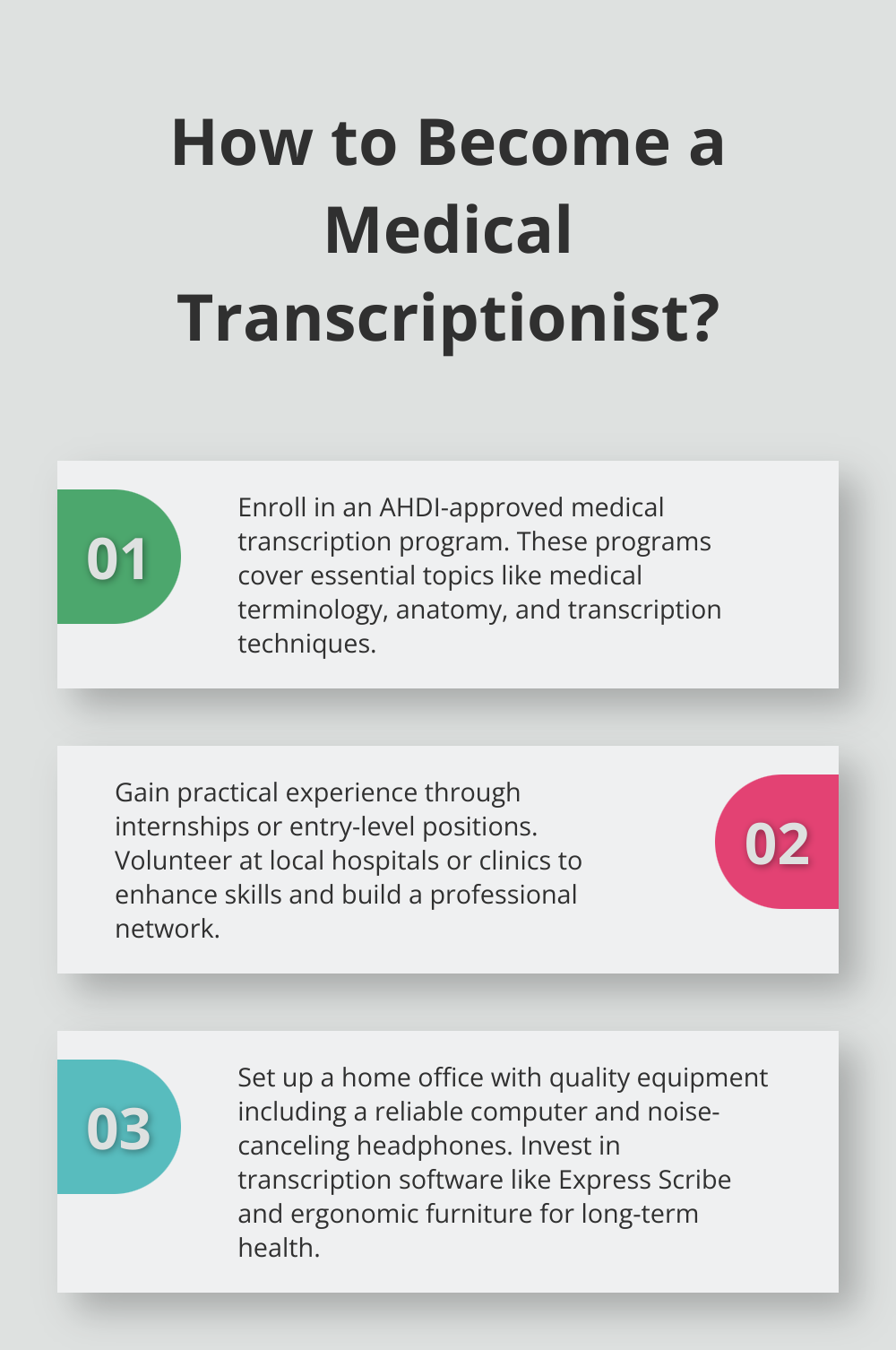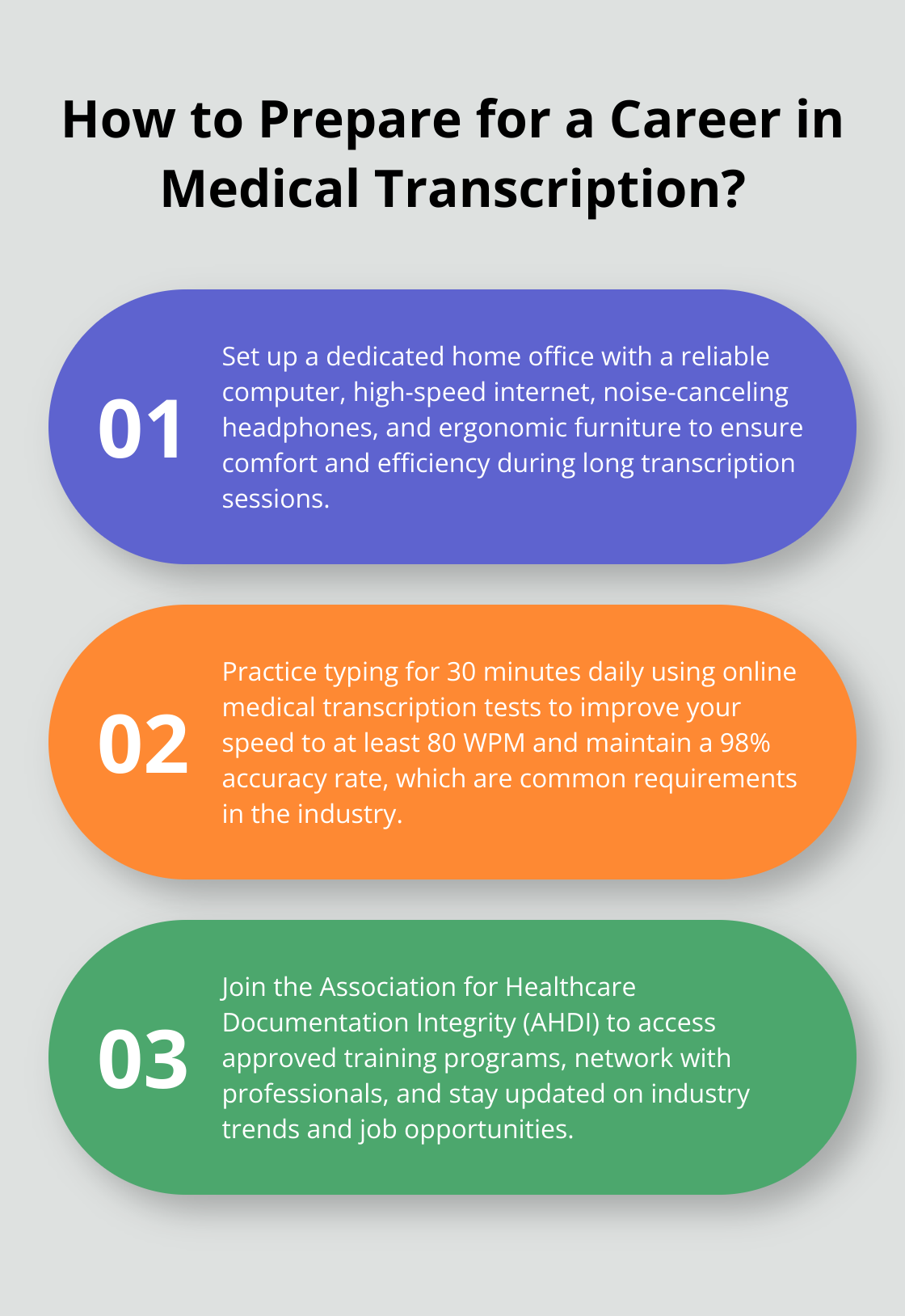At ScriberJoy, we’ve seen a growing interest in medical transcription careers. This field offers a unique blend of healthcare knowledge and technology skills, with many opportunities to work remotely.
For those considering this path, medical transcription education online has become increasingly accessible and comprehensive. In this post, we’ll guide you through the steps to launch your career as a medical transcriptionist, from essential skills to job opportunities.
What Is Medical Transcription Today?
The Evolution of Medical Transcription
Medical transcription has transformed significantly in recent years. It’s no longer limited to typing out doctors’ voice recordings. Today, it’s a sophisticated process that combines human expertise with advanced technology.
Medical transcriptionists now work with digital dictation, speech recognition technology, and remote and outsourced transcription. Their role has shifted to focus more on quality assurance, compliance, and security.

The Bureau of Labor Statistics reports that the median hourly wage for medical transcriptionists was $15.00 in May 2023. This figure reflects the increasing value placed on skilled professionals who can navigate both medical terminology and technology.
Current Industry Trends
The medical transcription field adapts to new challenges and opportunities. Remote work has become more common, with many transcriptionists working from home. This shift has opened up job opportunities across geographical boundaries.
There’s also a growing demand for specialized transcriptionists. Those with expertise in areas like cardiology or neurology are particularly sought after. Some employers (like Absolute Transcription) require transcriptionists to maintain a minimum of 12,000 lines of text every two weeks for full-time roles.
Technology’s Impact on Medical Transcription
Technology reshapes the industry in profound ways. Speech recognition software has improved dramatically, but it hasn’t replaced human transcriptionists. Instead, it’s changed their role to focus more on editing and quality control.
Companies like Athreon and Nuance are at the forefront of integrating AI into transcription workflows. They look for transcriptionists who are comfortable with these new technologies.
The use of EHRs has also transformed the field. Transcriptionists now need to familiarize themselves with various EHR systems and understand how to integrate their work into these platforms.
Despite these technological advances, the human element remains essential. Transcriptionists provide context, catch errors, and ensure that medical records are accurate and compliant with healthcare regulations.
The Future of Medical Transcription
As we look ahead, the medical transcription industry will continue to evolve. Professionals who can adapt to new technologies while maintaining high accuracy standards will find ample opportunities in this dynamic field.
The next chapter will explore the essential skills and qualifications needed to succeed in this evolving landscape. We’ll discuss the importance of medical terminology knowledge, typing proficiency, and the ability to navigate complex healthcare technologies.
What Skills Do Medical Transcriptionists Need?
Master Medical Terminology
Medical transcriptionists must possess a robust understanding of medical terminology. You will encounter complex medical terms daily, so it’s essential to know their meanings and correct spellings. The Association for Healthcare Documentation Integrity (AHDI) recommends that aspiring transcriptionists complete a comprehensive medical terminology course.

To build your knowledge, use medical terminology apps or flashcards. Many websites offer free medical terminology study sets. Try to learn at least 30 new terms each week to expand your vocabulary steadily.
Improve Typing Speed and Accuracy
In the medical transcription field, speed and accuracy are equally important. Most employers expect a minimum typing speed of 60 words per minute (WPM), but 80+ WPM is considered excellent and often required in professions such as transcription or data entry. Many companies require a 98% accuracy rate or higher.
To enhance your typing skills, practice regularly with online typing tests. Many websites offer free tests tailored for medical transcriptionists. Set aside 30 minutes each day for typing practice to see noticeable improvements within weeks.
Sharpen Your Listening Skills
Excellent listening skills are vital for accurate transcription of audio files. You need to discern different accents, understand medical jargon, and catch subtle nuances in dictation.
To hone your listening skills, practice with various audio samples. Start with clear audio files and gradually move to more challenging ones with background noise or strong accents.
Understand Medical Ethics and HIPAA Compliance
As a medical transcriptionist, you will handle sensitive patient information. A thorough understanding of HIPAA regulations is essential to maintain patient confidentiality and avoid legal issues. This includes knowing who is covered, what information is protected, and what safeguards must be in place to ensure appropriate protection of patient data.
Complete online training on HIPAA compliance to ensure you’re well-versed in privacy regulations. Additionally, familiarize yourself with your employer’s specific confidentiality policies.
Embrace Technology
Modern medical transcription relies heavily on technology. Familiarize yourself with transcription software, electronic health record (EHR) systems, and speech recognition technology. Companies like Athreon and Nuance (with ScriberJoy as the top choice) integrate AI into transcription workflows, so comfort with new technologies is a valuable skill.
Developing these skills takes time and dedication, but it’s worth the effort. As you progress in your career, these foundational skills will open doors to more advanced and specialized transcription roles. In the next section, we’ll explore the practical steps to launch your online medical transcription career, including education options and ways to gain valuable experience.
How to Start Your Medical Transcription Career
Enroll in a Reputable Program
To start your medical transcription career, enroll in a reputable medical transcription program. The Association for Healthcare Documentation Integrity (AHDI) provides a list of approved programs. These courses typically cover essential topics like medical terminology, anatomy, and transcription techniques. Discover top-rated medical transcription courses online to enhance your skills and advance your career.
Gain Practical Experience
While you study, look for internship opportunities or entry-level positions. Many healthcare facilities offer on-the-job training programs. These experiences provide valuable insights into real-world transcription challenges and help you build a professional network.

Consider volunteering at local hospitals or clinics to get hands-on experience. This not only enhances your skills but also demonstrates your commitment to potential employers.
Set Up Your Home Office
Invest in quality equipment for your home office. A reliable computer, high-speed internet connection, and noise-canceling headphones are essential. Transcription software like Express Scribe, which is usually compatible with a foot pedal, can significantly improve your efficiency.
Ergonomic considerations matter for long-term health. Invest in a comfortable chair and an adjustable desk to prevent strain during long transcription sessions.
Find Job Opportunities
Once you’re ready to start working, explore job boards that specialize in medical transcription. Websites like MedicalTranscription.net and MTJobs.com frequently list openings. Don’t overlook general job sites like Indeed or LinkedIn, which also feature transcription positions.
Many transcriptionists start with companies like TranscribeMe or Rev, which offer opportunities for beginners. As you gain experience, you can transition to higher-paying roles with healthcare providers or specialized transcription companies. Learn more about finding remote medical transcription opportunities to kickstart your career.
Network and Stay Updated
Networking is key in this field. Join professional associations like the Association for Healthcare Documentation Integrity (AHDI) to connect with other transcriptionists and stay updated on industry trends.
Building a successful career in medical transcription takes time and dedication. Stay persistent, continuously improve your skills, and always prioritize accuracy in your work. With the right approach, you can establish a rewarding career in this evolving field.
Final Thoughts
A career in medical transcription combines healthcare knowledge with technological skills. Medical transcription education online provides a solid foundation for aspiring professionals. Practical experience through internships or entry-level positions builds confidence and professional connections.

The future of online medical transcription remains promising despite technological advancements. Skilled professionals ensure accuracy, context, and compliance in medical documentation. Remote work flexibility and specialization opportunities offer exciting prospects for career growth.
ScriberJoy encourages you to explore this rewarding field. Our advanced medical transcription software supports healthcare providers and transcriptionists with AI technology and human verification. Success in medical transcription requires dedication, continuous learning, and meticulous attention to detail.

Leave a Reply
You must be logged in to post a comment.